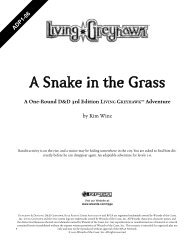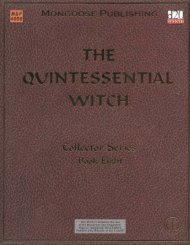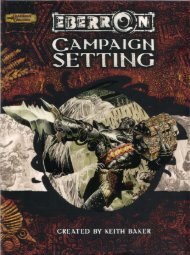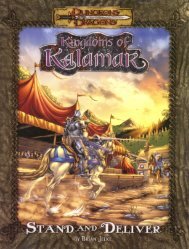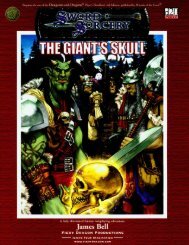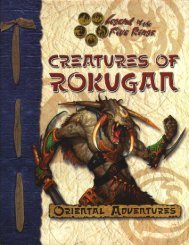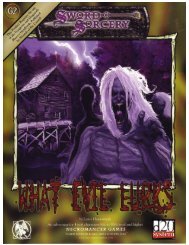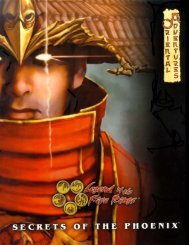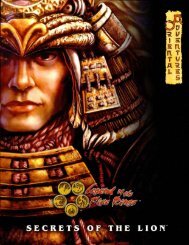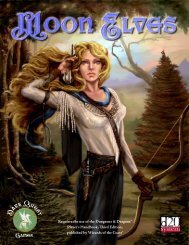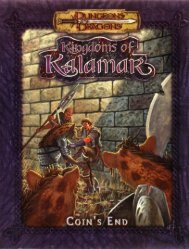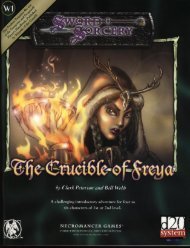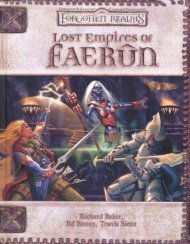Fang and Fury - Guidebook to Vampires.pdf
Fang and Fury - Guidebook to Vampires.pdf
Fang and Fury - Guidebook to Vampires.pdf
Create successful ePaper yourself
Turn your PDF publications into a flip-book with our unique Google optimized e-Paper software.
64<br />
Chapter Six: The Gods & Their Servants<br />
The Feasting Lord is a particularly sinister deity, because at first<br />
blush he appears innocuous <strong>and</strong> even benevolent. On the surface his<br />
cult’s teachings seem pleasant, <strong>and</strong> its activities are <strong>to</strong>lerated—even<br />
welcomed—in civilized areas where the truth has not yet been<br />
revealed. In reality Jejua is an ancient <strong>and</strong> hungry monster who drives<br />
his followers <strong>to</strong> ever more decadent <strong>and</strong> perverse pursuits.<br />
Jejua’s cult preaches the pleasures of a good <strong>and</strong> full life <strong>and</strong><br />
encourages followers <strong>to</strong> partake of all the fruits of hard work <strong>and</strong><br />
success. Only initiates of his cult know the reality behind these<br />
bl<strong>and</strong> pronouncements: Human flesh <strong>and</strong> blood are the church’s<br />
sacraments, <strong>and</strong> cannibalism is the only worship their lord accepts.<br />
All high priests of the cult are inducted in<strong>to</strong> the deeper mysteries,<br />
which culminate in their death <strong>and</strong> rebirth at the h<strong>and</strong> of the lead<br />
vampire. These mysteries are blasphemies beyond underst<strong>and</strong>ing, the<br />
holy writ filled with occult uses for all the organs <strong>and</strong> fluids of the<br />
human body, <strong>and</strong> with many secrets of esoteric power.<br />
When Jejua appears <strong>to</strong> the faithful, he resembles an impossibly<br />
obese man with the legs of a goat <strong>and</strong> piglike jaws who wears a<br />
<strong>to</strong>wering military helmet. He is covered in grease <strong>and</strong> cas<strong>to</strong>ffs from<br />
his feast, a <strong>to</strong>wering repast of human blood <strong>and</strong> body parts that<br />
always accompanies his manifestation. Any cultist who takes part in<br />
this cannibalistic orgy must make a successful Will save (DC 30) or<br />
take 2d6 points of permanent Wisdom drain <strong>and</strong> shift his alignment<br />
permanently <strong>to</strong> chaotic evil. A vampire who indulges in the great<br />
feast gains a +1 resistance bonus on all saves for the next year.<br />
Jejua is the patron of cannibals <strong>and</strong> killers, <strong>and</strong> many vampires pay him<br />
regular homage. Regents <strong>and</strong> revelers (see Chapter Four: Prestige<br />
Classes) are among his most faithful followers. He is associated with<br />
the gem, key, moon, <strong>and</strong> ruin cards from the deck of many things.<br />
MHKH (Demigod)<br />
The Magus, Opener of the Ways<br />
Symbol: A drawing of a tesseract<br />
Alignment: Neutral evil<br />
Weapon: Dagger<br />
Domains: Evil, Knowledge, Magic<br />
The entity known as MHKH is a vile<br />
mathematical abstraction that has been worshiped<br />
since the dawn of his<strong>to</strong>ry by those who seek secret <strong>and</strong> arcane<br />
knowledge. Its worship is endlessly complicated, <strong>and</strong> few even among<br />
learned sages know its true name—the acronym MHKH was created<br />
<strong>to</strong> keep the mind-blasting revelation of its nature from the casual<br />
reader. Those who worship it in earnest sink in<strong>to</strong> deep cogitation, only<br />
periodically emerging with the fruits of their flights in<strong>to</strong> the invisible<br />
world. Great advances in geometry, algebra, astronomy, <strong>and</strong> alchemy<br />
have been credited <strong>to</strong> its followers, but many who descend in<strong>to</strong> the misty<br />
l<strong>and</strong>s of reverie never return, their spirits tempted <strong>to</strong> follow trails of<br />
thought that have no destination <strong>and</strong> no end.<br />
No formal holy texts <strong>to</strong> MHKH exist. Instead, hints of its nature appear<br />
in pamphlets, hymnals, public notices, primers, his<strong>to</strong>ries, <strong>and</strong> snatches<br />
of overheard conversation—the initiate unpeeling significance from<br />
ciphers <strong>and</strong> veiled allusions. Most of these references are placed by<br />
people with no idea of their significance, a choice of words sparked by<br />
unusual inspiration; many report feeling full of ideas, or on the verge of<br />
a revelation, but this feeling quickly passes. Only the faithful are granted<br />
a glimpse of the whole picture, assembling it from these scraps like a<br />
painter rendering a l<strong>and</strong>scape from a thous<strong>and</strong> tiny studies.<br />
Races of Renown: <strong>Fang</strong> & <strong>Fury</strong><br />
MHKH has appeared in the world only a h<strong>and</strong>ful of times, each<br />
coinciding with a great discovery in mathematics <strong>and</strong> the sciences. Its<br />
physical form is immense, stretching out <strong>to</strong> cover whole city blocks<br />
or filling a wizard’s <strong>to</strong>wer. It resembles an animate fog dotted with<br />
bizarre geometric forms <strong>and</strong> peering eyes. Physical reality seems<br />
<strong>to</strong> bend <strong>and</strong> stretch in its presence, time flowing at great speed or<br />
even running backwards, <strong>and</strong> the laws of gravity <strong>and</strong> basic spatial<br />
relationships become as malleable as wax.<br />
A great number of sages <strong>and</strong> learned ones worship MHKH without<br />
being fully aware of it, believing instead that they are dedicated <strong>to</strong><br />
the pursuit of knowledge in its purest form. They make offerings in<br />
the form of time, their lives eroding decade by decade in the lonely<br />
pursuit of insight. Liches <strong>and</strong> some vampires—notably black abbots<br />
<strong>and</strong> vampire mages (see Chapter Four: Prestige Classes)—worship<br />
the deity consciously by disseminating forbidden knowledge <strong>and</strong><br />
sacrificing the innocence of the uninitiated.<br />
MHKH is symbolized by a mathematical expression of four<br />
dimensions, often drawn as the projected shape of a tesseract. He is<br />
associated with the donjon, Fates, <strong>and</strong> vizier cards from the deck of<br />
many things.<br />
Molkeegan (Demigod)<br />
Queen of Brambles,<br />
Queen of the Unseelie Court<br />
Symbol: A wreath of hawthorn<br />
roses, sometimes<br />
drawn in blood<br />
Alignment: Chaotic evil<br />
Weapon: Longbow<br />
Domains: Animal, Chaos, Evil, Plant<br />
Molkeegan began her climb <strong>to</strong> power as a lowly<br />
succubus in the service of a demon prince whose name is lost <strong>to</strong><br />
his<strong>to</strong>ry. Even by demonic st<strong>and</strong>ards, she was a vicious <strong>and</strong> spiteful<br />
creature whose hatred of elves <strong>and</strong> good fey was boundless. After<br />
several notable successes on the Material Plane, including her<br />
seduction <strong>and</strong> recruitment of a council of good druids, Molkeegan<br />
was promoted <strong>to</strong> the Abyssal nobility.<br />
Over time Molkeegan spread her influence across countless alternate<br />
realities, <strong>and</strong> eventually she overcame the bounds of corporeality <strong>to</strong><br />
become a demigod. Today her seat of power is a fortress deep in the<br />
brambles of a haunted forest that has expressions on infinite planes.<br />
Here she twists the good-natured spirits <strong>and</strong> fey of all worlds in<strong>to</strong><br />
dark, menacing shapes.<br />
The Queen of Brambles appears as a severely beautiful elf woman<br />
with the abdomen, legs, <strong>and</strong> wings of a monstrous wasp. She<br />
carries an intelligent longbow called Darkroot when hunting elves<br />
<strong>and</strong> fey. Her consort is Shedim, the Prince of Lycanthropes, <strong>and</strong><br />
they sometimes hunt <strong>to</strong>gether, their werewolf <strong>and</strong> unseelie minions<br />
ranging far ahead in pursuit of prey.<br />
Few vampires pay homage <strong>to</strong> Molkeegan, with the exception of<br />
foundlings (see Chapter Four: Prestige Classes), who serve<br />
her faithfully <strong>and</strong> execute her bidding in the material world. Most<br />
worship takes place in the Unseelie Court itself, which is filled with<br />
rio<strong>to</strong>us celebration <strong>and</strong> horrific <strong>to</strong>rture in equal measures. She is<br />
associated with the Euryale, flames, <strong>and</strong> talons cards from the deck of<br />
many things.



